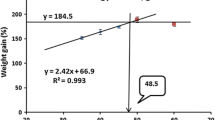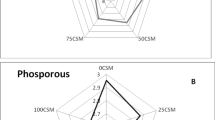Abstract
Seven species of snow trout (Schizothorax spp.), endemic to Indian Himalayas, were taken up for exploring their protein content, dietary protein contribution potential, amino acid composition and amino acid score. Protein contents in all the seven species were in the order of S. labiatus > S. plagiostomus > S. progastus > S. esocinus > S. curvifrons > S. richardsonii > S. niger. Statistically, S. labiatus was found to be significantly superior (p < 0.05) to S. progastus, S. esocinus, S. curvifrons, S. richardsonii and S. niger with respect to protein content. Correspondingly, the dietary protein contribution potential to pre-school children (2–6 years old) was found to be highest in S. labiatus. Out of the seventeen detected amino acids, alanine was abundant in S. curvifrons, S. esocinus, S. niger, and S. plagiostomus, and leucine in S. labiatus, S. progastus and S. richardsonii. Among the essential amino acids, leucine followed by phenylalanine was the most abundant amino acid in all the fishes. The amino acid score values of leucine, isoleucine and lysine for pre-school children were found to be highest in S. labiatus. Overall, S. labiatus showed distinctly protein concentration, dietary protein contribution potential and amino acid score especially for leucine, isoleucine and lysine.


Similar content being viewed by others
References
Semba RD (2016) The rise and fall of protein malnutrition in global health. Ann Nutr Metab 69(2):79–88
WHO (2007) Protein and amino acid requirements in human nutrition. WHO Technical Report series 935, World Health Organization, Geneva, Switzerland
FAO, IFAD, WFP (2013) The state of food insecurity in the world 2013—the multiple dimensions of food security. FAO, Rome
Bruke JM, Staples CR, Risco CA, Sota RL, Thatcher WW (1997) Effect of ruminant grade menhaden fish meal on reproductive and productive performance of lactating dairy cows. Dairy Sci J 80:3386–3398
Buttery PJ, D’ Mello JPF (1994) Amino acid metabolism in farm animals: an overview. In: D’Mello JPF (ed) Amino acids in farm animal nutrition. CAB Int, Wallingford, pp 1–10
Dahhar AA, Elshazly K (1993) Effect of essential amino acids (methionine and lysine) and treated oil in fish diet on growth performance and feed utilization of Nile Tilapia (L.). J Aquac Fish Manage 24(6):731–739
Jhingran VG (1982) Fish and fisheries of India. Hindustan Publishing Corporation, India
Sarma D, Tiwari T, Das P, Jha GN (2011) Proximate and mineral composition of indigenous hill stream fishes of Uttarakhand. Indian J Anim Nutr 28:203–206
Das P, Sarma D, Bisht HCS, Das P (2012) Nutritional quality of exotic rainbow trout (Oncorhynchus mykiss) and Indigenous snow trout (Schizothorax richardsonii) in upland Himalyan region. Indian J Anim Nutr 29(2):121–126
Sarma D, Akhtar MS, Das P, Das P, Shahi N, Yengkokpam S, Debnath D, Ciji A, Mahanta PC (2013) Nutritional quality in terms of amino acid and fatty acid of five coldwater fish species: implications to human health. Natl Acad Sci Lett 36:385–391
Mohanty B, Mahanty A, Ganguly S, Sankar TV, Chakraborty K, Rangasamy A et al (2014) Amino acid compositions of 27 food fishes and their importance in clinical nutrition. J Amino Acids 2014:1–7
Sarma D, Akhtar MS, Das P, Das P, Gadiya G, Shahi N, Ciji A (2014) Proximate and mineral composition of some selected coldwater fishes of upland Himalaya. Nutr Food Sci 44:554–561
Mohanty BP, Sankar TV, Ganguly S, Mahanty A, Anandan R, Chakraborty K et al (2016) Micronutrient composition of 35 food fishes from India and their significance in human nutrition. Biol Trace Elem Res 2016:1–11
AOAC (2000) Official method of analysis, association of official analytical chemists, Gaithersburg, 17th edn
Indian Council of Medical Research (2010) Nutrient requirements and recommended dietary allowances for Indians. http://icmr.nic.in/final/rda-2010.pdf. Accessed 28 Nov 2016
Ishida Y, Fujita T, Asai K (1981) New detection and separation method for amino acids by high-performance liquid chromatography. J Chromatogr 204:143–148
Njaa LR, Utne F (1982) A comparison of the amino acid composition of fifteen species of whole fish. Fisk Dir Skr Ernearing 2:25–33
Connell JJ, Howgate PF (1959) The amino-acid composition of some British food fishes. J Sci Food Agric 4:241–244
Somchit ZMN, Solihah MH, Goh YM, Arifah AK, Zakaria MS, Somchit N, Rajion MA, Zakaria ZK, Mat Jais AM (2006) Fatty acid and amino acid composition of three local Malaysian Channa spp. species. Food Chem 97:674–678
Adeyeye EI (2009) Amino acid composition of three species of Nigerian fish: Clarias anguillaris, Oreochromis niloticus and Cynoglossus senegalensis. Food Chem 113:43–46
Duyar HA (2000) Ph.D. Thesis, Department of Fisheries and Processing Technology, Institute of Natural and Applied Science, Ege University, p 118
Wesselinova D (2000) Amino acid composition of fish meat after different frozen storage periods. J Aquat Food Product Technol 9(4):41–48
Food and Agriculture Organization of the United Nations (2013) FAO expert consultation: dietary protein quality evaluation in human nutrition. FAO Food and Nutrition Paper 92, Rome
Etzel MR (2004) Manufacture and use of dairy protein fractions. J Nutr 134(4):996S–1002S
De Bandt JP, Cynober L (2006) Therapeutic use of branched-chain amino acids in burn, trauma, and sepsis. J Nutr 185(1):308S–313S
Wu G, Meininger CJ (2002) Regulation of nitric oxide synthesis by dietary factors. Annu Rev Nutr 22:61–86
Malinski T (2000) The vital role of nitric oxide. Oakl Univ J 1:47–57
Kim SW, Mateo RD, Yin YL, Wu G (2007) Functional amino acids and fatty acids for enhancing production performance of sows and piglets. Asian Aust J Anim Sci 20:295–306
Charlton M (2006) Branched-chain amino acid enriched supplements as therapy for liver disease. J Nutr 136(1):295S–298S
Vuzelov E, Krivoshiev S, Ribarova F, Boyadjiev N (1999) Plasma levels of branched chain amino acids in patients on regular hemodialysis before and after including a high-protein supplement in their diet. Folia Med 41(4):19–22
Van der Hulst RR, van Kreel BK, von Meyenfeldt MF, Brummer RJ, Arends JW, Deutz NE, Soeters PB (1993) Glutamine and the preservation of gut integrity. Lancet 341:1363–1365
Acknowledgements
This research work was carried out as a part of PhD dissertation of the first author under outreach project of ICAR-DCFR, Bhimtal. The authors are grateful to Director, ICAR-Directorate of Coldwater Fisheries Research (ICAR-DCFR), Bhimtal for his valuable guidance to carry out the studies.
Author information
Authors and Affiliations
Corresponding author
Ethics declarations
Conflict of interest
The authors declare that they have no conflict of interest.
Additional information
Significance statement
This is the first documentation of amino acid compositions of seven different species of snow trout (Schizothorax spp.), which are the preferred food fishes for their palatability and nutritional value. This information is valuable to local mass who consume these fishes, nutritional scientists and nutritionists to formulate a dietary guideline.
Rights and permissions
About this article
Cite this article
Joshi, V., Akhtar, M.S., Sharma, P. et al. Protein and Amino Acid Composition of Indian Himalayan Snow Trout and Their Dietary Significance. Proc. Natl. Acad. Sci., India, Sect. B Biol. Sci. 88, 1471–1476 (2018). https://doi.org/10.1007/s40011-017-0889-1
Received:
Revised:
Accepted:
Published:
Issue Date:
DOI: https://doi.org/10.1007/s40011-017-0889-1




